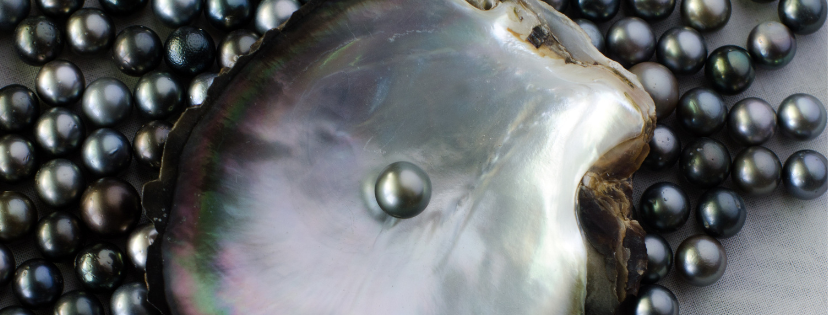Pearls - the Birthstone for June

Pearls - the birthstone for June
At Jewel Beetle, we're great fans of both Black Pearls and our very own New Zealand Blue Pearls. In this blog, we've compiled some interesting information about Black pearls - nature's beautiful creation.
Unlike most other gemstones which are minerals, pearls are organic and are formed by living marine organisms. This natural occurrence happens when an oyster or mussel receives an irritant inside its shell. To protect itself, the mollusc deposits layers of ‘nacre’ over the irritant. Just like the shell, the ‘nacre’ is made up of calcium carbonate. This iridescent coating is what makes these gems so beautiful. These layers build up over time and this is how the pearl is formed.
The ideal and most valuable pearl is smooth and perfectly round but some pearls are irregular in shape, these are called baroque pearls. Naturally occurring pearls are rare and far more valuable than their cultivated cousins.
Pearls can be cultivated in both freshwater and saltwater. Cultured pearls are more commonly used in jewellery. The process in simple terms involves a surgical-like procedure of adding a 'seed' or bead which acts as an irritant, therefore the pearl begins its natural process of coating the irritant with nacre. This process is called pearl seeding or nucleation.
The nacre of each pearl varies depending on its place of origin. Ideally the longer the pearl is left to grow the thicker the nacre it will produce. In places like Japan where pearl farming is more intensive, the Japanese 'Akoya' pearls have nacre that measures about a half-millimetre. The nacre of Tahitian and Cook island pearls is about 2 to 3 millimetres. South Sea pearls develop the thickest nacre from 2 to 6 millimetres.
South Sea pearls, Tahitian and Cook Island pearls take 2 to 3 years to form. Japanese Akoya pearls are harvested in a shorter period of less than 2 years.

Cultured Black Pearls
Cultured black pearls are farmed in saltwater and grown in oysters. Only one pearl is grown per oyster. This makes salt-water pearls more expensive than freshwater pearls. Pearl farming is found in Australia, Burma, Indonesia, Thailand, Philippines, Cook Islands and Tahiti in South Pacific. Tahitian pearls are famous for their beautiful black pearls.

We source most of our black pearls from our pacific neighbours in the Cook Islands. From the clear lagoon depths of Manihiki, Rakahanga and Tongareva (Penrhyn) mother nature captures the rich lagoon colours and transforms them into a profusion of green, blue, purple and silver-hued pearls. Manihiki, known as 'The Island of Pearls' operates a small sustainable farming operation and are relative newcomers to the Pearl industry.


The nacre of each pearl varies depending on its place of origin. Ideally the longer the pearl is left to grow the thicker the nacre it will produce. In places like Japan where pearl farming is more intensive, the Japanese Akoya pearls have a nacre that measures about a half-millimetre. The nacre of Tahitian and Cook island pearls is about 2 to 3 millimetres. South Sea pearls develop the thickest nacre from 2 to 6 millimetres. South Sea pearls and Tahitian pearls take 2 to 3 years to form. Japanese Akoya pearls are harvested in a shorter period of less than 2 years.

Black Pearl Jewellery
We have recently purchased a large selection of Cook Island Black Pearls and are ready to create some beautiful Black Pearl jewellery.
Below: A picture of some of the loose black pearls we have in stock at Jewel Beetle

What to do with loose pearls?
Have you purchased a loose pearl on an overseas holiday and it's still sitting in a box hiding away? We're happy to design a special piece for you. Over the years we've created many beautiful items of Black Pearl jewellery. Take a look at our some of our black pearl jewellery below for some inspiration!
Or take a look at our Black Pearl collection for sale online.
How to care for your Black Pearls
Pearls are organic and made up of calcium carbonate with a hardness of only 2.5-3.5 Mohs scale. They are quite soft so care needs to be taken when wearing and handling these precious beauties.
It's advisable to put on your pearls last when getting dressed to avoid exposure to chemicals like perfume or hairspray. Pearls are very sensitive to chemicals, especially acidic-based chemicals or food. Store them in a separate box away from direct sunlight. Avoid extreme heat which can also damage the pearl's lustre.
Pearls can be cleaned with a very soft cloth and a diluted wool wash solution.
If you have purchased your pearls from us don’t forget that we are happy to take care of cleaning them for you free of charge.




